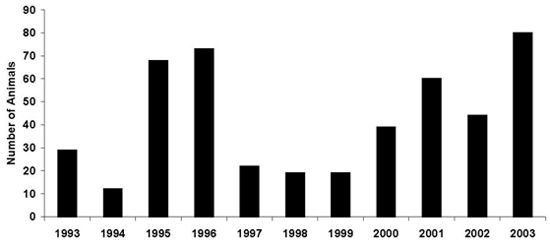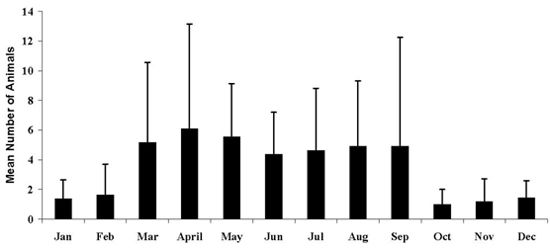Sea Turtle Strandings and Mortality on the Central West Coast of Florida, 1993-2003
Abstract
From 1993-2003, 465 stranded sea turtles from the Gulf of Mexico along the central west coast of Florida were examined by Mote Marine Laboratory personnel and volunteers, with the recovery effort concentrating in Sarasota County (n=387). The yearly mean number of stranded sea turtles was 42.3 (± 24.4 SD). There were 89 males, 118 females, and 258 animals of unknown gender. The greatest number of sea turtles stranded in 2003 (n=80) and the lowest number stranded in 1994 (n=12) (Figure 1). The majority of turtles (n=392) stranded between March and September, with a peak in April (n= 67). The mean monthly strandings ranged from a low of 1.0 (± 1.0 SD) turtles in October to 6.1 (± 7.1 SD) turtles in April (Figure 2). Years with multiple months of greater than 9 sea turtles stranding per month were 1995, 1996, and 2003. Red tide blooms were present during these months of increased strandings. The predominant species recovered was the loggerhead (Caretta caretta, n=265), followed by the Kemp's ridley (Lepidochelys kempi, n=106), green (Chelonia mydas, n=68), hawksbill (Eretmochelys imbricata, n=11), leatherback turtle (Dermochelys coriacea, n=5) and 10 animals of unidentified species. Of the 465 animals stranded, 423 animals (90.1%) stranded dead or died while undergoing rehabilitation. Of these animals, 71.4% (n=302) were not given a post-mortem examination due to the carcasses not being recovered (n=10) or due to advanced decomposition and/or partial remains being present (n=292). Post-mortem examinations were performed on the remaining 121 animals. Cause of death was determined by gross necropsy and/or histopathology findings. In 76 of the cases cause of death could not be determined due to advanced decomposition (n=63) or open diagnoses (n=13). The mortality categories of the remaining animals (n=45) included fisheries/human interaction (n=20), and natural diseases (n=25). Fisheries/human interactions included animals with entanglements that caused death by drowning, and animals with trauma secondary to boat strikes. Natural diseases included bacterial, viral, and parasitic diseases, emaciation, gastrointestinal obstructions/perforations, hypothermia, and predation. An additional 12 animals stranded live due to fisheries/human interactions including entanglements and entrapments (swimming pools, beach armoring), however these animals were released within 24 hours of stranding.
| Figure 1. Yearly sea turtle strandings. | 
|
|
| |
| Figure 2. Monthly mean number of stranded sea turtles. | 
|
|
| |